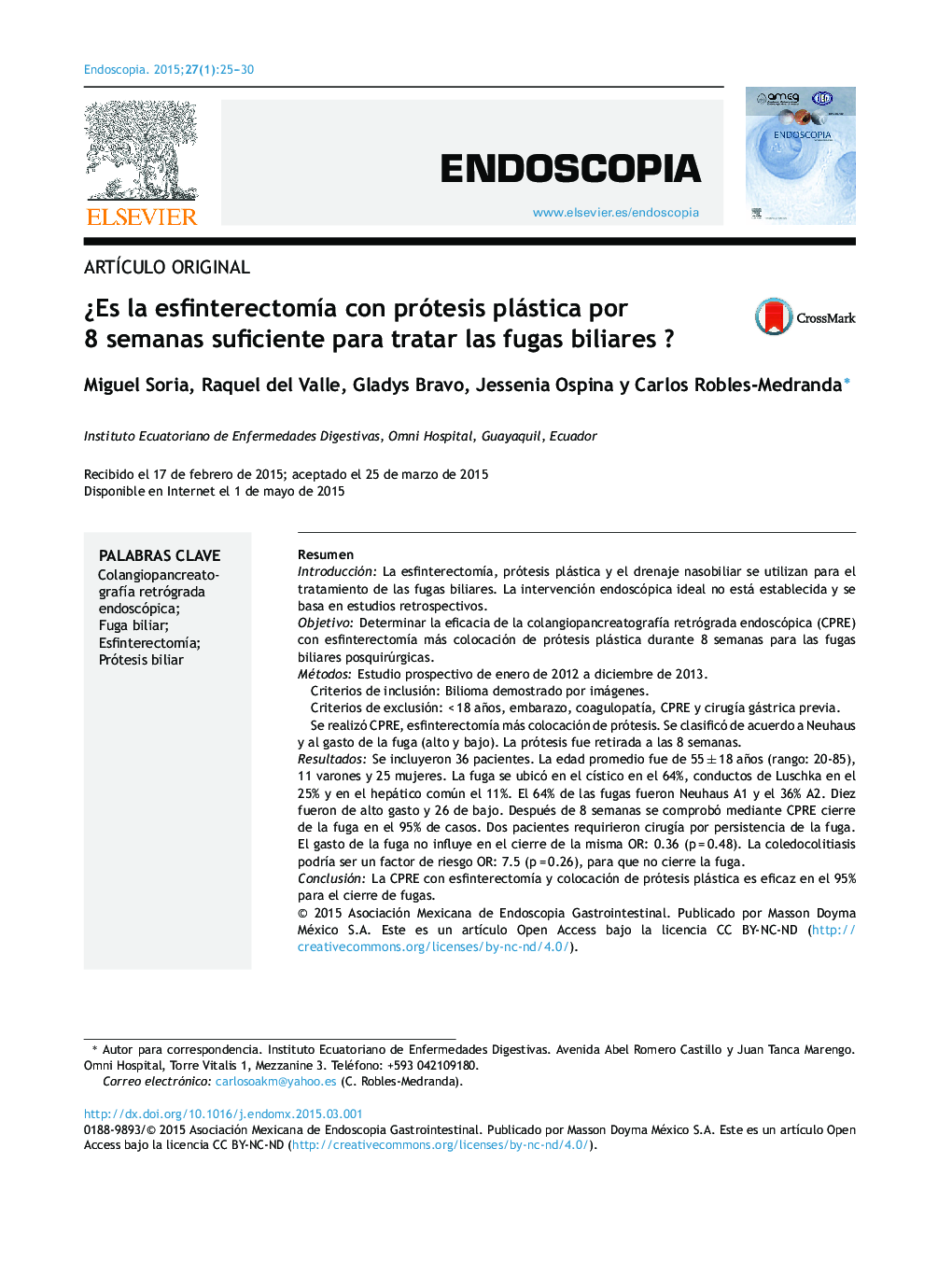| کد مقاله | کد نشریه | سال انتشار | مقاله انگلیسی | نسخه تمام متن |
|---|---|---|---|---|
| 3287529 | 1209440 | 2015 | 6 صفحه PDF | دانلود رایگان |

ResumenIntroducciónLa esfinterectomía, prótesis plástica y el drenaje nasobiliar se utilizan para el tratamiento de las fugas biliares. La intervención endoscópica ideal no está establecida y se basa en estudios retrospectivos.ObjetivoDeterminar la eficacia de la colangiopancreatografía retrógrada endoscópica (CPRE) con esfinterectomía más colocación de prótesis plástica durante 8 semanas para las fugas biliares posquirúrgicas.MétodosEstudio prospectivo de enero de 2012 a diciembre de 2013.Criterios de inclusión: Bilioma demostrado por imágenes.Criterios de exclusión: < 18 años, embarazo, coagulopatía, CPRE y cirugía gástrica previa.Se realizó CPRE, esfinterectomía más colocación de prótesis. Se clasificó de acuerdo a Neuhaus y al gasto de la fuga (alto y bajo). La prótesis fue retirada a las 8 semanas.ResultadosSe incluyeron 36 pacientes. La edad promedio fue de 55 ± 18 años (rango: 20-85), 11 varones y 25 mujeres. La fuga se ubicó en el cístico en el 64%, conductos de Luschka en el 25% y en el hepático común el 11%. El 64% de las fugas fueron Neuhaus A1 y el 36% A2. Diez fueron de alto gasto y 26 de bajo. Después de 8 semanas se comprobó mediante CPRE cierre de la fuga en el 95% de casos. Dos pacientes requirieron cirugía por persistencia de la fuga. El gasto de la fuga no influye en el cierre de la misma OR: 0.36 (p = 0.48). La coledocolitiasis podría ser un factor de riesgo OR: 7.5 (p = 0.26), para que no cierre la fuga.ConclusiónLa CPRE con esfinterectomía y colocación de prótesis plástica es eficaz en el 95% para el cierre de fugas.
IntroductionSphincterotomy, nasobiliary drain and plastic stents are used for the treatment of biliary leaks. The ideal endoscopic intervention is not well established and many results are based on retrospective studies.ObjectiveTo determine the effectiveness of endoscopic retrograde cholangiopancreatography (ERCP) with sphincterotomy with plastic stents for 8 weeks in the treatment of biliary leak.MethodsProspective study from January 2012 to December–2013.Inclusion criteria: Biloma diagnosed by imaging methods.Exclusion criteria: < 18 years, pregnancy, coagulopathy, previous gastric surgery and ERCP.ERCP, sphincterotomy and plastic stent placement was performed. Biliary leaks were classified according to Neuhaus and biliary output as high or low. The stent was removed at 8-weeks.ResultsThe study included 36 patients. The mean age was 55 ± 18 years (range 20-85), with 11 males, and 25 females. The leak was located: at cystic stump in 64%, 25% at Luschka ducts, and 11% at the common hepatic duct. The leaks were classified as Neuhaus A1 in 64%, and A2 in 36%, with 10 cases with a high output and 26 low. After 8-weeks, the biliary leak closure was confirmed by ERCP in 95% of cases, with 2 patients requiring surgery due to persistent leak. The output of the leak does not influence the closing (OR: 0.36; P = .48). Choledocholithiasis could be a risk factor (OR: 7.5; P = .26) for bile leak failure.ConclusionERCP with sphincterotomy and plastic stent placement is effective in 95% to close biliary leakage.
Journal: Endoscopia - Volume 27, Issue 1, January–March 2015, Pages 25–30